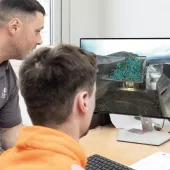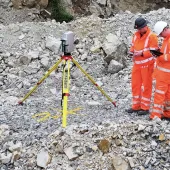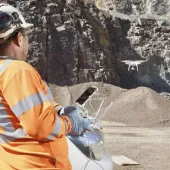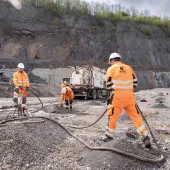EPC-UK help polar scientists find answers

UK blasting specialist supplies explosives for environmental research in Arctic and Antarctic regions
EPC-UK are a leading name in the provision of explosives and drilling and blasting services within the commercial sector, but as the company continues to evolve, calls for its products have further diversified into areas of scientific research.
Highlighting projects not typically associated with EPC-UK’s core portfolio of services, commercial manager Ryan Ward points to a British Antarctic Survey (BAS) research programme that is utilizing the company’s products.
‘EPC-UK’s blasting specialisms are well regarded in the UK and beyond, especially in the fields of quarrying and construction,’ explained Mr Ward. ‘However, in recent years we’ve been presented with opportunities to supply products and relevant training to support key scientific research.’
BAS is a component body of the Natural Environment Research Council. Its remit is environmental research in the Earth’s polar regions – both Arctic and Antarctic. In particular, BAS is responsible for conducting or supporting most of the UK’s scientific research in Antarctica.
The research group includes scientists and academic researchers, one of whom is glaciologist Dr Andy Smith, science leader of the ice dynamics and palaeoclimate team. He spends the Antarctic summer season studying the glaciers that drain the Antarctic ice sheet.
Currently, Mr Smith and his team are performing investigative work within one of Antarctica’s most unstable glaciers, working as part of the International Thwaites Glacier Collaboration (ITGC).
They join more than 60 scientists and students who are exploring the ocean and marine sediments, measuring currents flowing toward the deep ice, and examining the stretching, bending and grinding of the glacier over the landscape below.
It is likely that the glacier has become more vulnerable to changes in the environment in recent decades and, consequently, considerable international effort is under way to understand how the ice sheet behaves and what might happen to it in the future.
One strand of Mr Smith’s team’s work involves looking at what lies beneath the glacier – a major factor in controlling the way the ice flows and behaves. EPC-UK explosives have been used to help his team perform this key research by allowing seismic surveys to be conducted safely.
These surveys allow Mr Smith to map the landscape beneath the ice and, more importantly, determine the nature of the material the ice is resting on; whether it is solid rock, soft sediments or lakes trapped beneath.
‘Seismic surveys are simple in principle,’ he said. ‘Create a burst of sound, then listen to the reflections that bounce back. The trick is to tweak those basic principles to your particular interest – in our case, what lies beneath the ice.
‘In glaciology, the sharper the sound source is, the better it works,’ he added. ‘This is why, to give the ice a short, sharp kick, we have to choose the most effective explosives, as in our experience explosives have proved by far the best energy source for looking at what lies underneath the ice.’
Mr Smith went on to explain how Antarctica is naturally a quiet environment, with remarkably low background noise levels. This allows charge sizes to be kept as small as possible and yet still deliver high-quality data.
‘As Antarctica is still a remote place compared with the rest of the world, many supplies are brought by ship just once a year,’ he said. ‘Explosives required for a seismic survey need high energy density and velocity of detonation and must also be bought to the operation’s storage site a minimum of 14 months before they will actually be used.’
The materials need to remain stable, as they spend time in storage during the Antarctic winter. For Mr Smith’s team, fieldwork resumes in the spring and involves a stable supply of EPC-UK’s Pentolite cast primers – designed to provide high density and velocity of detonation and which prove effective when used in small charge sizes of approximately 300g.
‘Accurate timing is essential to achieving corresponding seismic data and initiation is always performed using electric seismic detonators,’ explained Mr Smith. ‘Performing the process involves preparing a shot hole 20m deep; drilled using a jet of hot water. The primed charge is then lowered to the bottom of the hole.’
Mr Smith explained that at this depth, the snow is still porous and any residual water from the drilling will have drained away. Furthermore, as the hole is stemmed with snow, coupling is improved and there is no shortage of natural stemming material.
Once the holes are prepared, the team can fire the shots and record the data accordingly. If a hole has been primed well, the subsequent explosion created is nominal, as the objective to ensure minimum surface disturbance and to direct as much energy as possible downwards.
Occasionally the team needs to look deeper into the Earth, which requires changes to be made to the drilling, loading and firing operation, and can necessitate charge sizes of up to 500kg or more of ANFO (ammonium nitrate fuel oil). Drilling sufficient holes for this amount of product is challenging for small scientific teams, so the ANFO is buried in a shallow pit, dug into the snow’s surface.
‘Our team’s use of explosives for research on the ice streams of Antarctica requires operational systems that are simple but efficient,’ said Mr Smith. ‘EPC-UK materials are effective and we’ve benefitted from training from their in-house blast specialists, and other providers, which has proved extremely useful.
‘We hope that by processing and analysing the data we’re creating, the seismic sections we’ve revealed will show us not only the shape of the glacier bed, but the kind of material it is made of.
‘These scientific variations have the capacity to affect ice flow in different ways, which makes mapping the geology beneath the ice a necessary step that must be achieved before we can predict how ice flow might change and affect us all in future.’









